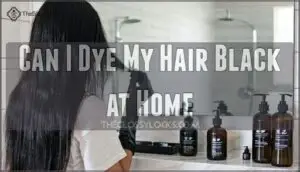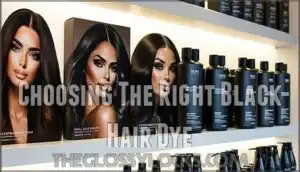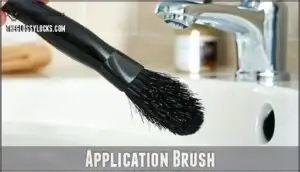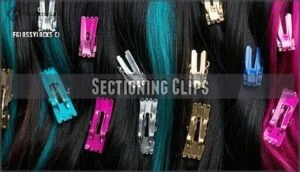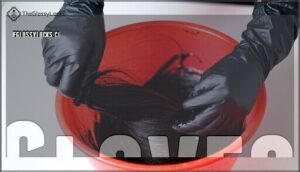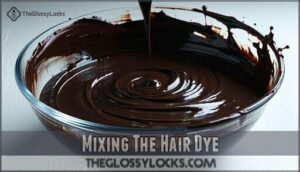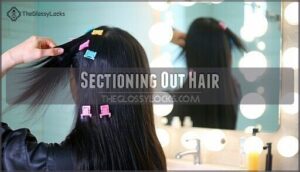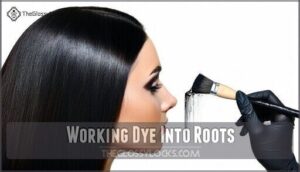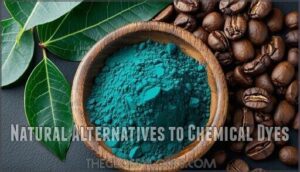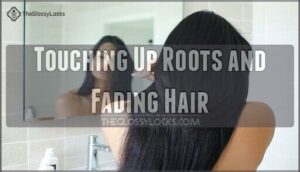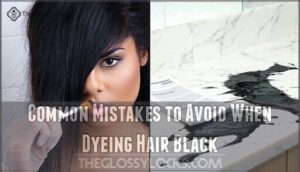This site is supported by our readers. We may earn a commission, at no cost to you, if you purchase through links.
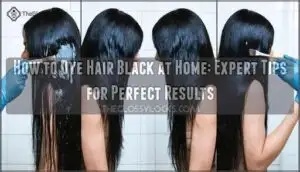
Start with clean, dry hair—skip conditioner a day before to help the color stick.
Put on gloves, drape an old towel over your shoulders, and apply petroleum jelly along your hairline to block stains (trust me, black dye loves to linger).
Mix the dye per the instructions, section your hair into four parts, and brush the dye onto roots first, then mid-lengths and ends.
Let it develop as directed.
Rinse with cool water and condition for shine.
Ready to rock glossy black strands?
Table Of Contents
- Preparing Hair for Black Dye
- Can I Dye My Hair Black at Home
- Choosing The Right Black Hair Dye
- Essential Tools and Materials Needed
- How to Dye Hair Black: Step-by-Step
- Maintaining Your New Black Hair Color
- Natural Alternatives to Chemical Dyes
- Caring for Dyed Black Hair
- Touching Up Roots and Fading Hair
- Common Mistakes to Avoid When Dyeing Hair Black
- Frequently Asked Questions (FAQs)
- Can I dye my hair black by myself?
- What can I dye my hair black with at home?
- How can I make my hair black at home?
- Do I need to bleach my hair to dye it black?
- Can I dye my hair black?
- How do I dye my hair at home?
- Can I DIY my hair color if I have dark hair?
- Can You dye darker hair at home?
- How to darken hair naturally?
- How do you clean a dyed hair?
- Conclusion
Preparing Hair for Black Dye
Before you apply black dye, you’ll need to prep your hair properly to guarantee even coverage and protect your strands from damage.
Prep your hair like a pro—proper care before black dye ensures rich, even color and healthy, protected strands.
Think of this step like priming a wall before painting—skip the prep work, and you’ll likely end up with patchy, uneven results that’ll have you reaching for a hat.
Avoid Washing Before Dyeing
The golden rule of at home hair dye preparation is to skip washing your hair 24-48 hours before dyeing. Your natural oils create a protective oil barrier that shields your scalp from harsh chemicals while boosting dye adherence.
Think of it as your hair’s built-in armor system. This pre-dye routine works magic because it utilizes the natural benefits of unwashed hair to improve the dyeing process.
Here’s why this pre-dye routine works:
- Natural oils protect your scalp from chemical irritation and burns
- Unwashed hair absorbs black dye more evenly across different hair porosity levels
- Oil barrier prevents over-processing and maintains hair health during coloring
- Dirty hair grips pigment better than squeaky-clean strands
- Less washing means stronger hair cuticles for ideal color results
Clarifying Shampoo for Buildup
While skipping your regular wash protects natural oils, you’ll need a clarifying shampoo if your hair carries heavy product residue.
This deep-cleaning powerhouse removes stubborn buildup that blocks your black hair dye from penetrating evenly.
Choose sulfate-free shampoo types for gentler hair purification without stripping essential moisture.
Use it 24-48 hours before your at home hair dye session.
Think of it as prep work—your hair dye kit will thank you with richer, more uniform color results.
Thorough Detangling
Before you dye hair black, proper detangling prevents uneven color distribution and breakage.
Smart detangle methods start with the right tools and technique.
Follow these detangling tips for smooth results:
- Start at hair ends, work upward – prevents additional knots
- Use wide-tooth hair combs – gentler than hair brushes
- Apply detangling spray – reduces friction during tangle removal
- Work in small sections – guarantees thorough coverage
- Be patient – rushing damages hair before dyeing
The provided detangling tips are crucial for achieving smooth results and preventing hair damage before dyeing.
Barrier Cream Application
You’ll want to apply barrier cream generously around your hairline before starting your hair dye application.
This skin protection step prevents stubborn stains that can last for days.
Petroleum jelly works perfectly if you don’t have specialized cream types, and you should focus on your forehead, ears, and neck area.
These application tips guarantee stain prevention while following proper hair dye safety and preparation guidelines.
Can I Dye My Hair Black at Home
You absolutely can transform your hair with black hair dye at home – it’s like having your own personal salon right in your bathroom! With proper preparation and the right hair dye kit, dyeing hair black becomes totally manageable.
Transform your look with black hair dye at home—your personal salon awaits with the right prep and tools!
Understanding Hair Color Theory helps you choose between jet black, blue-black, or soft black options that complement your features.
Here’s what you need to think about before diving in:
- Choose quality At-Home Kits from reputable brands for consistent results
- Master Dye Damage Prevention by doing strand tests and following timing instructions
- Research Black Shade Options that work with your natural undertones
- Plan your Color Maintenance Tips strategy before you even start dyeing
- Gather proper tools including gloves, brushes, and barrier cream for protection
Home hair dyeing success comes down to patience, preparation, and realistic expectations about the process.
To achieve the best results, review coloring hair safely to prevent damage and guarantee a professional-looking finish.
Choosing The Right Black Hair Dye
You can’t just grab any black hair dye from the shelf and expect salon-quality results, especially since different formulas work better on various hair types and colors.
The key to achieving that perfect raven-black shade lies in matching the right dye type to your current hair color and considering your skin tone, because trust me, the wrong choice can leave you looking like you stuck your finger in an electrical socket, which is why choosing the right dye is crucial.
Understanding Dye Types
Understanding your options empowers you to make the right choice.
Permanent dyes penetrate deeply, lasting months but requiring commitment. Semi dyes wash out gradually, perfect for experimenting. Natural alternatives like henna offer gentler options.
Each dye formula creates different color deposits – choose wisely for your desired black transformation.
When selecting a black hair dye, consider the various black hair options available to achieve the best results.
| Dye Type | Duration | Commitment Level | Hair Damage |
|---|---|---|---|
| Permanent | 4-6 months | High | Moderate |
| Semi-Permanent | 6-8 washes | Low | Minimal |
| Natural | 2-4 weeks | Medium | None |
| Temporary | 1-2 washes | Very Low | None |
Picking The Right Shade
Choosing the perfect black hair dye shade can make or break your transformation.
Your hair type and current color level determine which dye formulas work best for stunning results.
- Natural black dyes offer subtle depth without harsh chemicals
- Hair dye shades range from soft black to jet black intensity
- Color chart guidance guarantees proper shade selection for your goals
Considering Skin Tone
Finding the perfect black hair dye isn’t just about the shade—it’s about tone matching with your skin undertones.
Whether you’ve got fair skin or a dark complexion, the right black hair color can enhance your features beautifully.
| Skin Undertones | Best Shade | Avoid |
|---|---|---|
| Cool (pink undertones) | Cool tones (blue or ash blacks) | Warm tones (red or brown blacks) |
| Warm (yellow undertones) | Warm tones (red or brown blacks) | Cool tones (blue or ash blacks) |
| Neutral (balanced tones) | Neutral black (pure black) | Personal preference applies |
For individuals with dark skin, considering a hair color that complements their tone, such as the dark skin tones guide, is essential for achieving a natural look.
For flawless hair dye application, consider natural black dyes like henna for a softer, skin-tone-friendly finish.
Essential Tools and Materials Needed
Before you start, make sure you’ve got all the right tools and materials to keep the process smooth and mess-free.
From gloves to sectioning clips, having everything ready will save you from scrambling mid-dye, as it allows for a more complete setup that ensures the dyeing process is efficient.
Application Brush
A hair dye application brush is your secret weapon for flawless black hair dye results.
The right brush guarantees smooth dye distribution and precise control, especially around tricky areas like roots.
Opt for a medium-sized brush for versatility and easy handling.
Always clean your brush after use to avoid color mixing and extend its lifespan.
Mastering proper brush techniques, like gentle strokes and even pressure, prevents patchy results.
Using the right hair dye tools is vital for achieving professional-looking results.
- **Choose quality brushes for durability.
- **Clean brushes thoroughly after each use.
- **Use medium-sized brushes for control.
- **Apply dye with consistent strokes.
- **Store brushes properly to maintain shape.
Sectioning Clips
Don’t wrestle with tangles while dyeing—hair dye sectioning clips are your secret weapon for smooth application.
Divide your hair into neat sections for even coverage using durable, no-slip clips.
Here’s a quick guide:
| Clip Type | Material | Best For | Clip Placement | Sectioning Tips |
|---|---|---|---|---|
| Alligator Clips | Plastic | Thick Hair | Roots to Ends | Use 4-6 clips evenly |
| Duckbill Clips | Metal | Fine Hair | Top Layers | Secure small sections |
| Butterfly Clips | Plastic | Medium Hair | Full Sections | Space clips evenly |
| Jaw Clips | Plastic/Metal | Long Hair | Bottom Layers | Hold larger sections |
| Snap Clips | Metal | Short Hair | Sides | Use for precision areas |
Master hair dye application techniques with these trusty tools for stress-free home hair dyeing!
Old Towels
Old towels are your unsung heroes during home hair dyeing.
Lay them over countertops, sinks, or floors for quick Dye Protection and easier Surface Cleaning.
They catch stray splashes of black hair dye, sparing you from stubborn Stain Removal later.
Use one around your shoulders to shield clothing or wrap your hair post-dye for moisture control.
No extras? Repurpose an old T-shirt instead.
Remember, these aren’t for luxury—just practical Cleanup Tips to simplify your hair dye instructions.
Gloves
After grabbing old towels, it’s time to protect your hands with hair dye gloves.
Choose from latex gloves, nitrile options, or vinyl, depending on your preference and sensitivity. These glove materials shield your skin during hair dye mixing and application, preventing stains and irritation.
Opt for snug glove sizes to maintain control while working. Trust us, hand protection guarantees no black smudges distract from your hair dye preparation masterpiece!
When styling your newly dyed hair, consider using hair styling tools to achieve the perfect look.
How to Dye Hair Black: Step-by-Step
Dyeing your hair black at home is easier than you think when you follow a clear, step-by-step process.
From mixing the dye to ensuring even coverage, we’ll guide you through every stage for professional-looking results.
Mixing The Hair Dye
Now comes the fun part—mixing your black hair dye! Follow the dye ratio in your hair dye kit instructions carefully to achieve the perfect color depth.
Use the right developer type for your hair type and mix until you reach a smooth, creamy dye consistency.
- Think of a silky chocolate mousse.
- Imagine glossy ink flowing smoothly.
- Picture a velvety midnight sky.
Only prepare what you’ll use, as mixed dye doesn’t store well, to ensure you have the perfect color depth.
Sectioning Out Hair
Hair sectioning is your roadmap to flawless black hair dye results.
Divide your hair into four sections—or more for thick locks—using sectioning clips. This guarantees even strand separation and precise root application. Think of it as painting by numbers for your hair!
Clip Techniques Parting Methods
Applying Petroleum Jelly
Before grabbing the black hair dye, protect your skin with a quick petroleum jelly application.
Smear a thin layer along your hairline, ears, and neck—this creates a reliable hairline barrier against stains.
Think of it as your armor against stubborn dye marks, it’s a simple yet genius trick to keep the focus on your vibrant hair, not endless stain removal battles.
Working Dye Into Roots
Start with hair sectioning to make the root application easier.
Use your brush to apply the dye directly to the hair dye roots, facilitating thorough dye saturation for even color deposit.
Work in small sections, focusing on consistent root coverage without overloading the brush.
Think of it as precision painting—steady strokes prevent patchy spots.
To master this hair dye technique, take your time and check for missed areas.
A smooth hair dye application guarantees flawless hair dye at home results.
Coating Mid-lengths and Ends
Now that your roots are done, focus on the mid-lengths and ends for even saturation.
Here’s how:
- Sectioning Importance: Work in small sections to guarantee no strands are missed.
- Application Techniques: Use a dye brush, applying evenly without overload.
- Processing Time: Massage gently, blending into roots for consistency.
Home dyeing black hair? These hair dye techniques make your hair dye application seamless and salon-worthy!
Maintaining Your New Black Hair Color
Keeping your black hair color vibrant takes a little effort but is totally worth it.
By using color-safe products and avoiding common pitfalls like overwashing, you’ll keep your shade looking rich and glossy for weeks.
Using Color-Safe Shampoo and Conditioner
Using color-safe shampoos and conditioners preserves your black hair dye’s vibrancy.
Look for sulfate-free options to avoid stripping color. A key step is to use products that prevent color fading and maintain your hair’s health.
Here’s a quick guide:
| Concern | Key Points |
|---|---|
| Sulfate Concerns | Avoid sulfates; they dull the shade. |
| Ingredient Analysis | Check for nourishing ingredients like argan oil. |
| Hydration Benefits | Guarantees moisture stays locked in. |
| Color Longevity | Maintains rich tones over time. |
| Brand Comparisons | Consider Pureology or Redken for black hair care. |
Stick to washing twice weekly.
Hydrating Hair Masks
If you’re rocking black hair dye, hydrating hair masks are your secret weapon for maintaining that deep, lustrous color. Think of them as your hair’s insurance policy! Keep your strands healthy and vibrant with weekly treatments.
- DIY Masks: Avocado and coconut oil restore moisture and shine.
- Ingredient Benefits: Protein-rich masks repair damage and balance dryness.
- Application Frequency: Use once a week—more if needed—to prevent brittleness.
For ideal results, consider how natural ingredients promote growth. Protect your investment in your hair dye at home with nourishing treatments that enhance shine and longevity!
Limiting Sun Exposure
Your black hair deserves TLC, especially under the sun.
UV hair products like sprays are lifesavers, shielding your strands from fading. Don protective hairstyles or a chic hat for double-duty protection.
Opt for early mornings or late afternoons to dodge peak sun exposure. Sunscreen sprays aren’t just for skin—use them lightly on your part.
With proper hair dye sun protection, your at-home hair dye job will stay rich, radiant, and as bold as you, with proper care to maintain its color.
Avoiding Excessive Washing
Don’t overdo it on the washing—your black hair dye thrives when you space washes out.
Stick with sulfate-free shampoos, and try dry shampoo to handle oil buildup and control odors.
Excessive washing can strip your scalp’s natural oils, weakening color vibrancy.
Remember, black hair maintenance is a balancing act: protect the shade while keeping scalp health in check!
Natural Alternatives to Chemical Dyes
If you’re looking to skip chemical dyes, natural options like henna, indigo, and even coffee offer safe and gentle ways to darken your hair.
These alternatives may take a bit more patience, but they’re perfect for achieving rich, lasting tones without damaging your strands.
Henna and Indigo
Achieving a deep, natural black with henna and indigo is a rewarding DIY hair dye option.
Start with henna for a warm base, then apply indigo powder for rich, dark shades. A vital step involves securing complete root coverage during the henna application.
- Henna benefits: Strengthens hair and adds shine.
- Indigo shades: From dark blue to black.
- Mixing ratios: Equal parts henna and indigo guarantee vibrant results.
Coffee as a Natural Dye
Not into henna? Coffee’s your natural hair dye hero. Brew a strong, dark roast, let it cool, and mix it with used coffee grounds. Apply this DIY hair dye generously, leave it on for an hour, then rinse.
While it’s no permanent fix, it’s great for subtle darkening and gray coverage. Repeat every two weeks for lasting results.
Coffee Dye Benefits Brewing Coffee Dye Application Techniques
Caring for Dyed Black Hair
Keeping your dyed black hair vibrant and healthy requires a few simple adjustments to your routine.
From using sulfate-free shampoos to avoiding excessive heat, these steps will help maintain your color and prevent unnecessary damage, ensuring your hair remains healthy.
Sulfate-Free Shampoos and Conditioners
Sulfate-free shampoos and conditioners are lifesavers for maintaining black hair dye. They gently cleanse without stripping natural oils, ensuring color longevity and scalp sensitivity.
When choosing, focus on ingredient analysis—look for nourishing elements like argan oil or panthenol. Want eco-friendly options? Many sulfate alternatives also reduce environmental impact!
- Opt for color-safe products specifically for dyed hair.
- Check labels for moisturizing ingredients.
- Avoid harsh chemicals that weaken hair.
- Use sulfate-free formulas for gentle cleansing.
- Prioritize reputable brands for effective hair dye maintenance.
Reducing Shampoo Frequency
Washing your hair less often is key to keeping black hair dye vibrant.
Over-washing strips natural oils, leading to dryness and scalp buildup. Instead, try dry shampoo or co-washing to refresh hair without fading the color.
- Dry shampoo absorbs oil and adds volume.
- Co-washing gently cleanses while hydrating.
- Product choice matters—use color-safe options.
- Preserve natural oils to maintain shine and health.
Cool Water Rinses
Cool water rinses are a game-changer for at-home hair coloring.
They seal the cuticle, locking in your black hair dye while enhancing shine and promoting scalp health.
Skip the hot water—it strips color and dulls vibrancy.
Instead, rinse with cool water to boost color retention and minimize fading.
It’s a simple step that keeps your hair dye looking fresh and radiant longer.
Regular Deep Conditioning Treatments
Deep conditioning is a must for keeping your black hair dye looking fresh and your strands healthy.
Here’s how to make it work:
- Mask Ingredients: Use masks with coconut oil or shea butter for hydration.
- Application Frequency: Apply weekly for ideal results.
- Leave-in Conditioners: Add lightweight leave-ins for daily moisture.
- DIY Recipes: Blend avocado and honey for a nourishing, budget-friendly option.
Your hair will thank you!
Avoiding Heat Styling
Skip the flat iron and embrace air drying to keep your black hair dye looking fresh and vibrant.
Heat styling can strip color and weaken hair texture, so lean into protective styles like braids or buns to reduce damage.
If you must use heat, stick to low heat settings and always apply heat protectants for hair dye heat protection.
Experiment with overnight curls or twists for effortless waves, and by avoiding excessive heat, you’ll preserve your color longer and maintain the healthy shine of your at-home hair dye results, ensuring a longer-lasting vibrant look.
Touching Up Roots and Fading Hair
Keeping your black hair color vibrant means staying on top of root touch-ups and addressing fading before it becomes noticeable.
With the right tools and techniques, you can maintain a polished, salon-worthy look from the comfort of home, which helps in keeping your hair color vibrant.
Scheduling Regular Touch-ups
Keeping your black hair vibrant means staying on top of root touch-ups every 4-6 weeks.
This routine keeps regrowth in check, guarantees gray hair coverage, and prevents noticeable color fading.
DIY root touch-ups work well with the right tools, but for tricky areas or uneven results, a professional can save the day.
Consistency is your secret weapon for flawless black hair dye maintenance, ensuring regrowth is kept in check and gray hair coverage is guaranteed.
Color-Correcting Products
Got uneven patches or unwanted green tones after dyeing? Color-correcting products are your best friends for fixing hair dye mishaps.
They tackle brassiness, red undertones, and other pesky issues. Here’s how:
- Color-depositing conditioners: Add pigment to refresh your hair color and neutralize brassiness.
- Toning shampoos: Gently correct green tones or enhance vibrancy.
- Toners: Precisely target uneven patches for a polished finish.
Use these hair dye products to keep your black shade flawless!
Fading Hair Color Safely
Fading black hair doesn’t mean giving up! Use gentle lightening techniques like color removers or oil treatments for a gradual progression.
Always prioritize damage control with deep conditioners.
For hair dye fading safely, follow this table:
| Step | Solution |
|---|---|
| Minimize damage | Use sulfate-free shampoo |
| Retain color | Wash with cool water |
| Seek professional advice | Consult a colorist |
Keep hair health first!
Common Mistakes to Avoid When Dyeing Hair Black
When dyeing your hair black at home, it’s easy to make mistakes that can lead to uneven color or damage.
By avoiding common errors like skipping a strand test or over-processing, you’ll set yourself up for a flawless, long-lasting result.
Over-processing
Over-processing black hair dye can wreak havoc on your strands, leaving them brittle and lifeless.
To protect hair elasticity and prevent chemical damage, always stick to the recommended timing during the dyeing process. Overdoing it can lead to dryness, breakage, and even scalp irritation.
Watch for signs like:
- Hair feeling gummy or overly stretchy.
- Patches of thinning or breakage.
- A dry, uneven texture post-dye.
- Scalp tenderness or burning.
Combat damage with protein treatments and focus on scalp health. Remember, healthy hair equals vibrant color and less stress!
Insufficient Strand Testing
Skipping the strand test is like gambling with your hair’s future. It’s a small step that prevents big regrets.
Here’s how to avoid hair dye mistakes:
- Mix a tiny amount of black hair dye.
- Apply to a hidden strand.
- Wait for the full processing time.
- Check for allergic reactions, uneven color outcome, or unexpected shade matching issues.
Your hair deserves this expert-level care, and taking the time to do a strand test will help you achieve the best results and avoid big regrets.
Inadequate Preparation
Rushing into at-home hair coloring without prepping is like painting on a dirty canvas—messy results!
Avoid uneven application by starting with unwashed hair to protect your scalp.
Assess hair health to prevent damage, and always perform an allergy test to dodge reactions.
Gather all tools beforehand, from gloves to black hair dye, ensuring smooth application, and remember that preparation is your secret weapon for stunning color results, which can lead to stunning color!
Using The Wrong Dye Type
Choosing the wrong hair dye type can lead to unexpected results—and not the good kind.
For long-lasting black, go with permanent, but if you’re experimenting, try semi-permanent.
Misjudging dye type effects or skipping a strand test might leave you with an unintended hue or even hair damage potential.
Also, natural dyes like henna can pose color longevity issues.
Research black hair dye products carefully to match your goals.
At-home hair coloring works best when you choose wisely!
Frequently Asked Questions (FAQs)
Can I dye my hair black by myself?
Dyeing your hair black yourself is like painting with precision—totally achievable with care.
Prep your hair, use gloves, follow instructions, and protect your skin.
Pay attention to shade choice and do a patch test first!
What can I dye my hair black with at home?
You can dye your hair black at home using a boxed permanent or semi-permanent black hair dye.
Choose a reputable brand, follow the instructions carefully, and don’t skip a patch test to guarantee safety.
How can I make my hair black at home?
Turning your hair black at home is like painting a masterpiece!
Grab a quality black dye, section your hair, apply from roots to ends, and follow instructions carefully.
Protect surfaces, wear gloves, and embrace the transformation!
Do I need to bleach my hair to dye it black?
You don’t need to bleach your hair to dye it black.
Black dye easily covers most natural shades, but if your hair is very light or bleached, a professional application guarantees even, rich coverage.
Can I dye my hair black?
Over 70% of DIY hair dye users choose black for its bold look.
Yes, you can dye your hair black!
Just prep properly, follow instructions, and protect your scalp with natural oils for best results.
How do I dye my hair at home?
Start by sectioning your hair, then mix the dye and developer as directed.
Apply to roots first, working through strands.
Protect skin with petroleum jelly, wear gloves, and rinse thoroughly after processing.
Follow with conditioner.
Can I DIY my hair color if I have dark hair?
With dark hair, use a high-quality black dye and follow instructions closely.
Focus on even application, sectioning your hair, and protecting your scalp.
Always strand-test first to avoid surprises or uneven results.
Can You dye darker hair at home?
Ever wonder if you can dye dark hair at home?
You can!
Use a high-quality black dye, follow instructions carefully, and prep with unwashed, detangled hair.
Always strand-test first to avoid surprises or damage.
How to darken hair naturally?
To darken hair naturally, try applying a mix of brewed black tea or coffee as a rinse.
Henna and indigo powders also work well.
Always strand-test first and protect surfaces from potential stains!
How do you clean a dyed hair?
Your dyed hair craves care!
Rinse with cool water until it runs clear, avoiding hot water.
Use a sulfate-free, color-safe shampoo sparingly.
Condition deeply to lock in moisture and preserve that stunning black hue.
Conclusion
Transforming your look with black hair dye at home doesn’t have to feel like walking a tightrope.
With the right prep, tools, and steps, you’ll achieve salon-worthy results. Remember, clean sectioning, proper application, and patience are your best allies.
Protect your hairline, follow instructions, and embrace color-safe care to keep your glossy black strands vibrant. Whether you’re after drama or elegance, knowing how to dye hair black at home guarantees your hair game stays strong and stunning.

